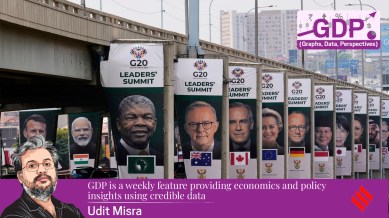Udit Misra is Senior Associate Editor. Follow him on Twitter @ieuditmisra ... Read More
© The Indian Express Pvt Ltd

The G20 summit is scheduled to start on Saturday (November 22) in Johannesburg. This is the last event before South Africa hands over the presidency of G20 to the United States. But here’s the rub: The US under President Donald Trump has refused to attend this summit because white Afrikaners were being “slaughtered” in South Africa. Before Trump made this claim, which is highly contested outside the White House, Vice President J D Vance was reportedly pegged to attend the summit.
But this decision by Trump has made everyone sit up and wonder about the future of the G20 itself.
As the events since the start of Trump’s second term as US president have shown, regardless of how big and well-represented a body may be, without the US involvement, little can be achieved, at least in the short term. For instance, the World Trade Organization rules of trade have not stopped Trump from slapping punitive and sweeping tariffs that are reordering global trade flows every day. Other big tents, such as the United Nations General Assembly, were already considered fairly weak and ineffectual.
Can a small and focused group of the biggest 20 economies make a difference?
The first problem is that G20 itself is a misnomer.
The grouping was created in 1999 after the Asian financial crisis of 1997-98, which showed that the G7 (or the seven most advanced economies) were unable to control matters because the world was far more unified thanks to rapid globalisation under the WTO framework.
So the initial idea was to have an informal forum for the finance ministers and central bank governors of the most important industrialised as well as the biggest developing economies to discuss international economic and financial stability.
In the wake of another global financial crisis — this time of 2007-08 — the G20 was “upgraded” to the level of Heads of State/Government to ensure necessary crisis coordination. Since 2009, the G20 Leaders have met regularly, and the G20 has become the premier forum for international economic cooperation.
But here is the misnomer part.
Far from the impression of a group of 20 most crucial countries, the G20 today includes the G7 countries (Canada, France, Germany, Italy, Japan, the UK, the US), the European Union, the Russian Federation, Argentina, Australia, Brazil, China, India, Indonesia, the Republic of Korea, Mexico, Saudi Arabia, South Africa, Turkey as well as the 55 member countries of the African Union. It is noteworthy that the EU itself has 27 member countries. In other words, the G20 is anything but a group of 20 countries.
Moreover, as the two charts show, there is little commonality among these countries. CHART 1 shows a selection of G20 members from across the planet on the per capita GDP scale — think of this as per capita incomes in these countries. The chart is sourced from Our World in Data, and figures here are in international dollars (not US dollars) and, as such show are adjusted for inflation and cost of living differences. In other words, the gap among countries is genuinely as big as it appears.
CHART 2 shows why per capita GDP is a good indicator of what happens in an economy. CHART 2 maps infant mortality — the percentage of newborns that die before reaching the age of 1. The line-up flips with the poorest countries witnessing much larger infant mortalities.
The point of these differences is to underscore that there may not be too much common among the G20 members. Furthermore, with G20 decisions not being binding on member countries and the US effectively abandoning the platform, especially at a time when, by rotation, it is supposed to take over the presidency and drive the agenda, it is anyone’s guess what lies ahead for the future of G20. The fact that the world is undergoing a phase of intense geopolitical instability just makes matters worse.